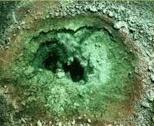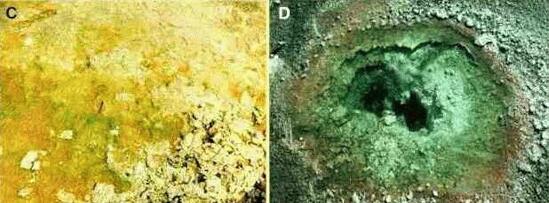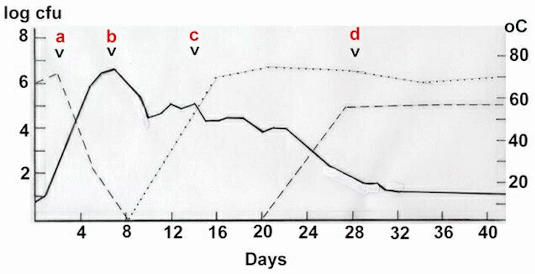A few thermophilic
prokaryotes can continue to grow during peak-heating and
persist during the prolonged high-temperature plateau,
when the termperature is maintained at between 40-60oC.
At this stage, a second group of thermophilic fungi start
to grow (c in Fig. E). These fungi
include Chaetomium thermophile, Humicola
insolens, Humicola (Thermomyces) lanuginosus
(Figure G), Thermoascus aurantiacus
(Figure H), a Paecilomyces-like
fungus (Figure I) and Aspergillus
fumigatus (Figure J). By their
combined activities, these fungi bring about a major
phase of decomposition of plant cell-wall materials such
as cellulose and hemicelluloses, so that the dry weight
of the compost can be halved during the relatively high
temperature phase lasting 20 days or more after peak
heating.Eventually
the temperature declines and mesophilic organisms then
recolonise the compost and displace the thermophiles (d
in Fig. E). However, some heat-tolerant species such as Aspergillus
fumigatus can continue to grow. This fungus can grow
at temperatures ranging from 12o to about
52-55o. Strictly speaking, it is not a
thermophile because its temperature optimum is below 50o,
but it is a very common and important member of the
high-temperature compost community.
|
Thermophilic
fungi of compostsAll
the thermophilic fungi shown below were obtained by
plating small particles of garden compost on
potato-dextose agar containing antibacterial agents
(streptomycin plus chlortetracycline) at 45oC.
|

Figure F. Rhizomucor pusillus.
Typical grey coloured colony on a plate of
potato-dextrose agar at 45oC (left-hand
image). This fungus produces abundant "fluffy"
aerial hyphae and spore-bearing stalks (sporangiophores)
which are branched (centre and right images) and have sporangia
at the tips of the branches. The delicate sporangial
walls break to release numerous spores, leaving only a
central bulbous region (the columella, c)
and remains of the sporangial wall (arrowhead in
right-hand image).
With a temperature range
of 20-55oC, this fungus is a typical early
coloniser of composts, exploiting simple sugars, amino
acids etc. that are present initially in the plant
material. It is inactivated during peak-heating, and it
does not recolonise afterwards.
|
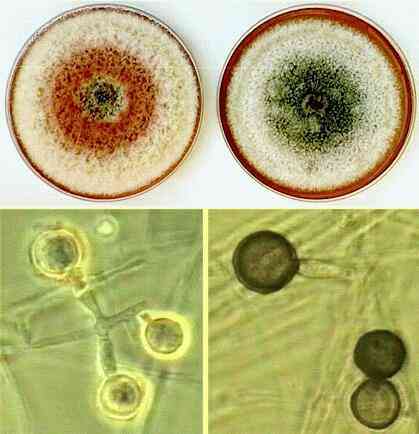
Figure G. Humicola (or
Thermomyces) lanuginosus. Colonies growing
on potato-dextrose agar (top left) and malt extract agar
(top right) at 45oC. This fungus produces
single spores by a balloon-like swelling process at the
tips of short hyphal branches (bottom, left). At maturity
(bottom right) the spores have brown, ornamented walls.
H. lanuginosus
grows from 30 to 52-55oC. It is extremely
common in all types of self-heating material and also in
birds' nests and sun-heated soils. It colonises composts
after peak-heating and persists throughout the
high-temperature phase. However, it cannot degrade
cellulose and it seems to live as a commensal with
cellulose-decomposing species, sharing some of the sugars
released from the plant cell walls by their cellulolytic
activities.
|

Figure H. Thermoascus aurantiacus
colony (left) growing on malt-extract agar at 45oC.
The orange-brown colour is caused by the presence of many
small (about 1 millimetre) fruiting bodies (ascocarps),
which are seen at higher magnification (top right). These
ascocarps are closed bodies, termed cleistothecia,
containing many asci, each with 8
ascospores. The cleistothecia and the ascus walls break
down at maturity to release the ascospores. Four asci
containing ascospores are shown in the composite image at
bottom right. They were released when a cleistothecium
was crushed on a slide, and they show ascospores in
various stages of maturity - the brown spores are nearly
mature.
This fungus grows from
about 25 to 55oC and is a vigorous cellulose
degrader.
|
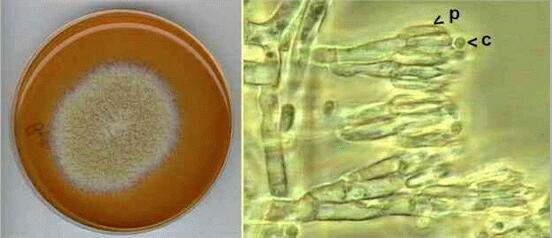
Figure I. Paecilomyces species
growing on malt extract agar at 45oC (left
image). The yellow-buff colour of the colony is caused by
the presence of asexual sporing structures on the aerial
hyphae. The sporing stages of the genus Paecilomyces
(right-hand image) superficially resemble those of
Penicillium, because the spores (conidia, c)
are formed from flask-shaped cells (phialides, p)
borne at the tips of short, brush-like branching
structures. But the branching pattern of these
"brushes" is less regular than in Penicillium.
|

Figure J. Aspergillus fumigatus.
This common fungus of composts and mouldy grain has a
grey-green colour on agar plates (left image), in
contrast to the brighter green colour of several other Aspergillus
species. The typical asexual sporing stage of Aspergillus
consists of a spore-bearing hypha (conidiophore,
centre image) which swells into a vesicle at the tip, and
the vesicle bears flask-shaped cells (phialides)
that produce the spores (conidia). In A.
fumigatus the vesicle typically is club-shaped, the
phialides arise only from the upper part of the vesicle,
and the phialides all point upwards. Together with the
grey-green colour and temperature range of about 12-52oC,
these features distinguish A. fumigatus from all
other Aspergillus species.
A. fumigatus is
an extremely common, interesting and dangerous fungus
because of its nutritional opportunism. It is strongly
cellulolytic, but it also can grow on hydrocarbons in
aviation kerosene, and it can enter the lungs as inhaled
spores, causing allergies or growing in the lung
cavities, causing aspergillomas (see Airborne
Microorganisms).
Its ability to grow readily at 37oC has made
this fungus a significant problem in operating theatres,
where it can establish infections of the internal organs
via surgical wounds, especially during transplant surgery
when the patient's immune system is suppressed.
|
The
prokaryotes of compostsAlthough the thermophilic fungi play a major
role in degrading cellulose and other major polymers in
composts, the activities of bacteria also are important.
Two recent discoveries highlight this point.
- In 1996 it was
reported that composts of many different types
(garden and kitchen wastes, sewage sludge,
industrial composting systems) contain high
numbers of bacteria of the genus Thermus
which grow on organic substrates at temperatures
from 40-80oC, with optimum growth
between 65 and 75oC. The numbers were
as high as 107 to 1010 per
gram dry weight of compost. Spore-forming Bacillus
species were also found, but they were
unable to grow above 70oC. Thus, it
seems that Thermus species, previously
known only from geothermal sites, have probably
adapted to the hot-compost system and play a
major role in the peak-heating phase. [T. Beffa et
al., 1996. Applied & Environmental
Microbiology 62,
1723-1727].
- Also in 1996, a
number of autotrophic
(self-feeding) bacteria were isolated from
composts. These non-sporing bacteria grew at
60-80oC, with optima of 70-75oC,
and closely resembled Hydrogenobacter
strains that previously were know only from
geothermal sites. They obtain their energy by
oxidising sulphur or hydrogen, and synthesise
their organic matter from CO2. [T.
Beffa et al., 1996. Archives of
Microbiology 165, 34-40]
|
Microbial
interactions in composts: commercial aspectsThere is much to be learned about
the interactions of microorganisms in composting systems.
Work in this field is driven largely by commercial needs
to produce composts for high mushroom yields (Agaricus
species) and for rapid, efficient processing of municipal
(domestic) and industrial wastes.
In contrast to the typical
"natural" composting sequence (Figure E),
commercial mushroom composts are produced by a truncated,
two-phase process, designed to minimise the loss of
cellulosic materials that Agaricus can use for
growth. Phase I involves peak-heating of straw compost to
70-80oC for several days. Then the compost is
pasteurised at 70oC and held at about 45oC
for a further few days (Phase II). Finally, the
temperature is lowered and the compost is inoculated with
Agaricus. Both of the preliminary phases are
essential for high mushroom yields. Recent work suggests
that the thermophilic fungus Scytalidium thermophilum
becomes dominant in phase II and its presence can almost
double the mushroom yield [G. Straatsma et al.,
1995. Canadian Journal of Botany 73,
S1019-1024]. The reason for this is still unknown.
Other work has shown that Agaricus
bisporus (the commercial mushroom) can use either
living or heat-killed bacteria as its sole source of
nitrogen for growth. Like many other members of the
fungal group basidiomycota, this fungus
does not thrive on inorganic nitrogen sources such as
ammonium or nitrate, but readily utilises organic
nitrogen, which it can degrade by releasing protease
enzymes. Thus, an initial high bacterial activity in the
compost might provide the fungus with its favoured
nitrogen source.
|
| Further reading - composting Websites:
Compost Resource Page.
A "general interest" site, good fun, but
perhaps a bit evangelical. http://www.oldgrowth.org/compost/
Glacier Gold Compost
Inc (a commercial composting company): http://www.speakeasy.org/ggc/
GO
TO FULL LIST OF PROFILES?
|
